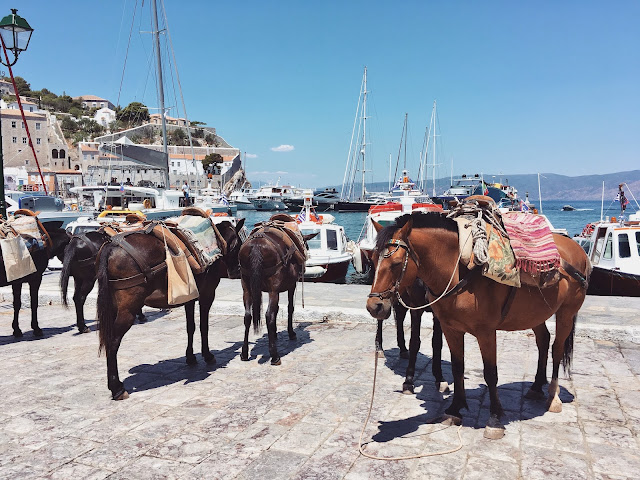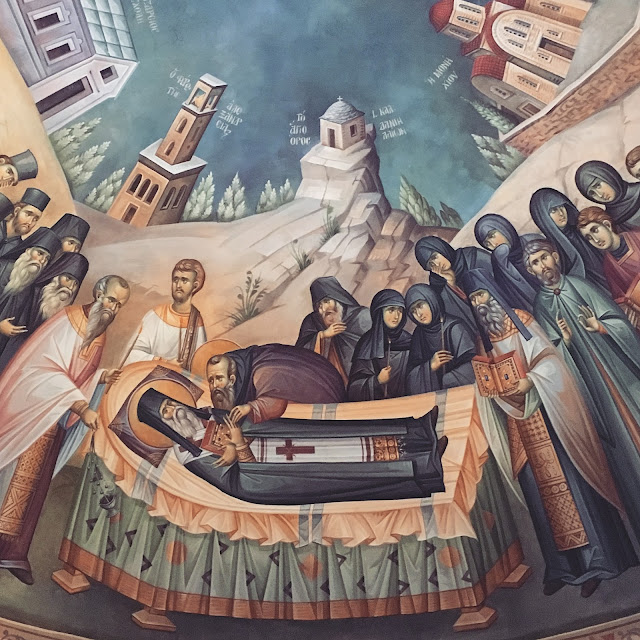From Athens to Aegina
The best of Greece not only resides within
Athens, but on those uncountable, mysterious and beautiful islands spreading on
Aegean Sea. During our discussion on schedule, I plan to visit either Santorini
or Mykonos for 3-day mini tour, while after we check the possibilities of
transportation, which is either being squashed inside of a narrow speedy boat
for over 5 hours between Athens and Mykonos, or we have to take flight again in
order to stay in Satorini, hubby and I decide to visit smaller but yet less
hardship choices to feel the REAL GREEK LIFE.
Greece has an extremely large amount of
islands, with estimates ranging from somewhere around 1200 to 6000, while the
number of inhabited islands is variously cited as between 166-227. The vivid
tourism culture provides various options, such as the local package tour
consists of a half-day Athens city walk or even a whole week grand tour of Greece.
At the counter of Dorian Inn Hotel, we book the cruise trip to Hydra, Póros
& Aegina, all we have to do is wake up early, prepare our mini pack and
wait for the tour bus at lobby at 06:50.
The tour bus picks us up at the gate of
hotel in order to the port of Flisvos Marina, at 08:14 the cruise ship (with
loads of Spaniards and Frenchmen) departs and sails for the first stopover on
the island of Hydra. The ship has a large upper deck to view the amazingly
marine blue of Aegean waves, and offers serve-to-table for all kinds of drinks.
No doubt I have my new favorite—Greek coffee—to accompany the sailing time. At
the first lower deck, the enlarged tweet sofa and mahogany tables make the
interior deco highly Venetian classic, and on the trip to Aegina, here we will
have our luncheon buffet, and at the second lower deck present the traditional
Greek music gigs.
HYDRA
Around 11:30, the first stopover on Hydra,
and we stay approximately one hour on the island. Hydra is one of the Saronic
Islands of Greece, locates in the Aegean Sea between the Saronic Gulf and the
Argolic Gulf, and the name of the island derived from the Greek word ‘water’
(in English comes with
‘hydration/hydrate/dehydration and so on), a reference to the natural
springs on the island. The main town, which also the cruise ships, small boats
and fancy yachts harbor, known ‘as Hydra Port’, where consists of numerous of
restaurants, shops, markets and galleries that cater to the tourists and
locals. Steep stone streets lead up and outward to the compact residential
areas, that within walking distances to door to door.
The most interesting part of Hydra is that
by law, cars and motorcycles are not allowed to operate. Horses, mules and
donkeys and water taxis provide public transportation, and the rubbish trucks
are the only motor vehicles on the island. At Hydra Port, we can see donkeys are
ready to carry goods uphill, also some are prepared for tourists’ riding
experiences. The young or old men transport bottled water and vegetables by the
wheeled trolley, the stray cats and friendly doggies hang around the pavement,
follow us around just after we say some hellos.
There is evidence of farmers and herders
from the second half of the third millennium BCE on the small, flat area of
Hydra. Having been surviving through eras of Byzantine, Venetian, Ottoman,
Greek Revolution and WW2, Hydra inhabitants abandoned their mansions and yards
for abroad, not until after 1960’s, Hydra benefits from numerous bays and
natural harbours, the island is now the popular yachting and tourist
destination. In 2007, National Geographic Traveler rated Hydra owns the highest
‘integrity of place’ than any other island of Greece.
PÓROS
Inhabiting around 4010 residences, Póros
with its neoclassical edifices, is built amphitheatrically on the slopes of a
hill. Its most famous landmark is a clock tower, completed in 1927. The passengers
from the cruise ship only have approximately an hour to discover the mysterious
passages. Still, we spot this unknown but strikingly beautiful pebble aisle,
standing with light pinkish walls and decorated windowsills. There is no any
better place to take fashion snaps and let the road lead to yet another
breathtakingly views!
Fashion Fun! Zara Straw Hat & AmericanApparel Disco Hot Pants Rock in Greek Island Life
Fashion Fun! Zara Straw Hat & AmericanApparel Disco Hot Pants Rock in Greek Island Life
On the track uphill to the clock tower,
Póros provides the most fuchsia tone of the bougainvillea bush topped on the
pure white wall, then offers the most reddish rooftops patchworks along the hilltop,
and greets people with the spiky yet greenery cactus at every corner turns. Finally
to the top, it is extremely burning hot on the site of the clock tower, but the
bird view toward to the Saronic Gulf, whichever click from camera/phone will immediately become the most bluish postcard.
AEGINA
After the buffet lunch at lower deck, where
provides feta cheese salad, grilled chicken rolls, beef slices and fresh
olives, we arrive to the last port, Aegina. At the beginning of the cruise
departures, the cabin crew promotes the optional tour visiting the Athena Afea
Temple or island fishing and swimming. We choose the bus tour to Athena Temple
and to Agios Nektarios Monastery.
Local tour bus picks us up immediately
after the cruise anchors at the port. Driving through the land of Aegina, an
extinct volcano constitutes two thirds of the island, where the northern and
western sides consist of stony but fertile plains, which are well cultivated
corps of grains, vines, olives, figs and pistachios. Arrive at the gate of
Athena Afea Temple, which dedicates to Aphaia (Afea), a Greek goddess who was
worshipped exclusively at this sanctuary. The extant temple built around in 570
BCE, Hellenistic Era, was destroyed by fire around 510 BCE. The process of
restoration has been undergoing since the 19th century; while the
marble sculptures from the east and west sides of pediments nowadays are on
display in the Glyptothek of Munich. Although Afea Temple is much tinier than
Parthenon in Athens, still the pillars from the east shows the colonnades of
the cella, the remains still picture the glorious days of the temple.
Saint Nektarios of Aegina was born as
Anastasios Kephalas in 1846 in Istanbul, Turkey. In 1904, he established Holy
Trinity Monastery on the island of Aegina and served his duty until 1908.
Entering the gate of monastery, I was immediately asked to cover the nearly
bare legs with a thick blanket. The marble floor is depicted with pigeons and
flowers mosaic tires, the whole tone of the interior deco of Agios Nektarios
Monastery are full of crimson, blue and gold.
Stepping out of the monastery, the sun
still burning high and bright; after I was asked from the passengers to take
some random photo shoots, we departure back to the cruise and sails toward
Athens. We arrive in the late evening at Dorian Inn Hotel, select our favorite
gyros wraps in the neighborhood, and enjoy the relaxing bedtime after the late instant dinner.
TOP TIP: Take the chance to discover those
uphill narrow passages of island, all the hidden surprises pop up at every
corner turns.
Special Thanks: JMH
#Hydra #Póros #Aegina #AthenaAfea #temple #monastery
Special Thanks: JMH
#Hydra #Póros #Aegina #AthenaAfea #temple #monastery

























No comments
Post a Comment